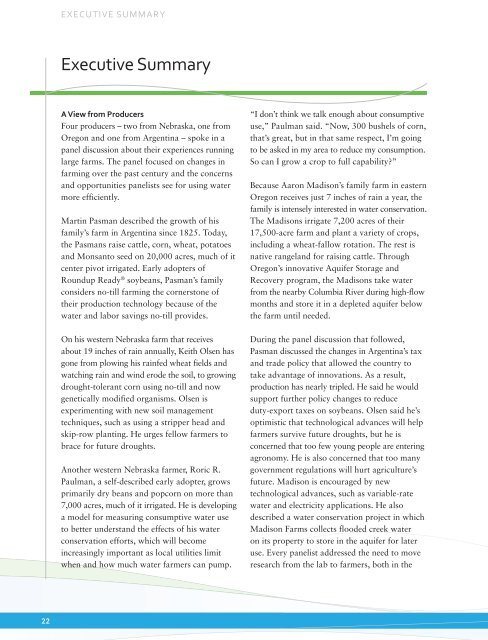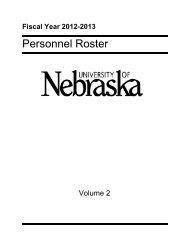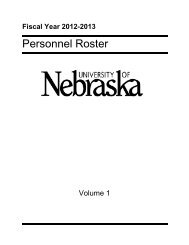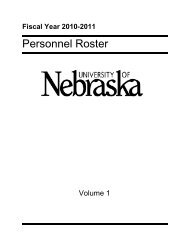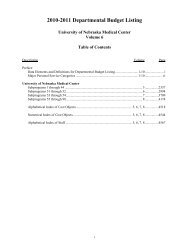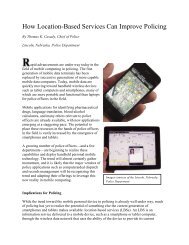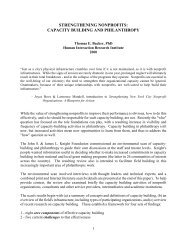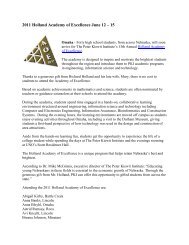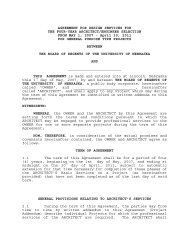Full Version - Water for Food Institute - University of Nebraska
Full Version - Water for Food Institute - University of Nebraska
Full Version - Water for Food Institute - University of Nebraska
You also want an ePaper? Increase the reach of your titles
YUMPU automatically turns print PDFs into web optimized ePapers that Google loves.
22<br />
EXECUTIVE SUMMARY<br />
Executive Summary<br />
A View from Producers<br />
Four producers – two from <strong>Nebraska</strong>, one from<br />
Oregon and one from Argentina – spoke in a<br />
panel discussion about their experiences running<br />
large farms. The panel focused on changes in<br />
farming over the past century and the concerns<br />
and opportunities panelists see <strong>for</strong> using water<br />
more efficiently.<br />
Martin Pasman described the growth <strong>of</strong> his<br />
family’s farm in Argentina since 1825. Today,<br />
the Pasmans raise cattle, corn, wheat, potatoes<br />
and Monsanto seed on 20,000 acres, much <strong>of</strong> it<br />
center pivot irrigated. Early adopters <strong>of</strong><br />
Roundup Ready ® soybeans, Pasman’s family<br />
considers no-till farming the cornerstone <strong>of</strong><br />
their production technology because <strong>of</strong> the<br />
water and labor savings no-till provides.<br />
On his western <strong>Nebraska</strong> farm that receives<br />
about 19 inches <strong>of</strong> rain annually, Keith Olsen has<br />
gone from plowing his rainfed wheat fields and<br />
watching rain and wind erode the soil, to growing<br />
drought-tolerant corn using no-till and now<br />
genetically modified organisms. Olsen is<br />
experimenting with new soil management<br />
techniques, such as using a stripper head and<br />
skip-row planting. He urges fellow farmers to<br />
brace <strong>for</strong> future droughts.<br />
Another western <strong>Nebraska</strong> farmer, Roric R.<br />
Paulman, a self-described early adopter, grows<br />
primarily dry beans and popcorn on more than<br />
7,000 acres, much <strong>of</strong> it irrigated. He is developing<br />
a model <strong>for</strong> measuring consumptive water use<br />
to better understand the effects <strong>of</strong> his water<br />
conservation ef<strong>for</strong>ts, which will become<br />
increasingly important as local utilities limit<br />
when and how much water farmers can pump.<br />
“I don’t think we talk enough about consumptive<br />
use,” Paulman said. “Now, 300 bushels <strong>of</strong> corn,<br />
that’s great, but in that same respect, I’m going<br />
to be asked in my area to reduce my consumption.<br />
So can I grow a crop to full capability?”<br />
Because Aaron Madison’s family farm in eastern<br />
Oregon receives just 7 inches <strong>of</strong> rain a year, the<br />
family is intensely interested in water conservation.<br />
The Madisons irrigate 7,200 acres <strong>of</strong> their<br />
17,500-acre farm and plant a variety <strong>of</strong> crops,<br />
including a wheat-fallow rotation. The rest is<br />
native rangeland <strong>for</strong> raising cattle. Through<br />
Oregon’s innovative Aquifer Storage and<br />
Recovery program, the Madisons take water<br />
from the nearby Columbia River during high-flow<br />
months and store it in a depleted aquifer below<br />
the farm until needed.<br />
During the panel discussion that followed,<br />
Pasman discussed the changes in Argentina’s tax<br />
and trade policy that allowed the country to<br />
take advantage <strong>of</strong> innovations. As a result,<br />
production has nearly tripled. He said he would<br />
support further policy changes to reduce<br />
duty-export taxes on soybeans. Olsen said he’s<br />
optimistic that technological advances will help<br />
farmers survive future droughts, but he is<br />
concerned that too few young people are entering<br />
agronomy. He is also concerned that too many<br />
government regulations will hurt agriculture’s<br />
future. Madison is encouraged by new<br />
technological advances, such as variable-rate<br />
water and electricity applications. He also<br />
described a water conservation project in which<br />
Madison Farms collects flooded creek water<br />
on its property to store in the aquifer <strong>for</strong> later<br />
use. Every panelist addressed the need to move<br />
research from the lab to farmers, both in the


